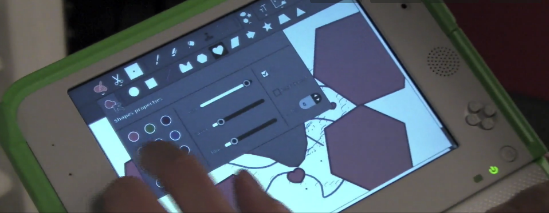Resumen en español al final del artículo
Yesterday Neonode, a company which develops and licenses touchscreen technologies, announced that OLPC has licensed its Neonode MultiSensing touch solution to be integrated in upcoming XO Touch models. As SJ Klein (OLPC Foundation's Director of Outreach) put it:
This week we signed a licensing agreement with them to embed their optical touchscreens into future 'XO Touch' laptops. The XO Touch will be a true laptop + tablet, with the same 7.5" sunlight-readable display, and Neonode's fast-scanning multitouch. There are a lot of applications I have in mind for those prototypes...
Neonode are energy-conscious, thanks to their history of work with mobile devices, and have features such as gesture-activated wakeup that will help the XO remain the lowest-power laptop around. Neonode is also proud of their screen's low-latency pen or brush sensors, and ability to sense proximity, pressure, and depth and measure object-size.
It's good to finally hear this official confirmation. After all an XO-1.75 with touchscreen was already discussed back in July 2010 and some early prototypes (which were caught on camera) were built for software developers in mid-2011 though at the time it was emphasized that OLPC had no plans to mass-produce such machines.

Early touchscreen prototype from mid-2011
Now it will be interesting to see just how far Sugar gets in terms of solid support for touch interactions until XOs with touchscreens starts shipping. Looking through the Sugar Labs wiki it's clear that much work remains to be done both on Sugar itself as well as many Activities. The ongoing transition to the GTK3 toolkit should certainly make that support easier from an implementation point of view.
However from a user interface (UI) design perspective I'm still worried that trying to use one interface for both touch and mouse/keyboard driven input leads to a less than stellar experience. For example it was never quite enjoyable to use the adapted tablet editions of Windows (traditionally very mouse/keyboard centric) on tablet PCs. And using the keyboard and touchpad dock for products such as ASUS Transformer series of Android tablets (traditionally touch driven) quickly makes many interactions with Android and its apps seem very odd indeed. So it comes as no surprise that industry heavy-weights such as Apple and Microsoft are currently hard at work to bridge that input gap in their flagship products such as OS X (which is increasingly adopting UI components from iOS), Windows 8, and Office 2013 (which are both supposed to work well on regular computers as well as tablets).
Overall this is certainly a significant design challenge and the fairly limited UI design resources available to OLPC and Sugar Labs don't help here. On the bright side there's prior work such as this 2009 paper which might prove useful, plus hopefully the deployments which will distribute XO Touch units are also dedicating some resources to utilize the full potential of a touchscreen with Sugar.
Speaking of deployments it's going to be interesting to see which ones will commit to XO Touch models. One would expect them to be slightly more expensive compared to the non-touch versions and until new software fully utilizes it I frankly speaking see little additional educational value that XO Touch models can provide.
Resumen en español: Ayer Neonode, una empresa que desarrolla y licencia tecnologías de pantalla táctil, anunció que OLPC ha licenciado su solución Neonode MultiSensing que se integrarán en futuros models llamados XO Touch.

